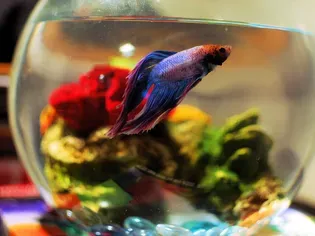How Many Bettas Can Live Together in the Same Tank?
Updated on 04/26/24

Unveiling the Secrets: A Comprehensive Guide on Cohabitating Bettas
Betta fish, renowned for their vibrant colors and flowing fins, are a popular choice in the aquarium hobby. However, when it comes to keeping multiple bettas together, the question of compatibility arises. In this extensive guide, we will delve into the fascinating world of betta cohabitation, exploring the intricacies of their behavior and providing practical advice on creating a harmonious underwater community.
Betta Basics: Understanding Their Temperament
Betta fish, particularly males, are known for their territorial nature and aggressive tendencies towards their own kind. This behavior stems from their natural competition for resources in the wild. In the confines of an aquarium, where resources are limited, this aggression can escalate, leading to fights and even fatalities.
The Role of Tank Size and Environment
While betta aggression is a fundamental trait, it can be influenced by the size and environment of their aquarium. A larger tank provides more space for bettas to establish their territories, reducing the likelihood of encounters. Additionally, providing ample hiding places, plants, and decorations can create visual barriers that break up the tank's line of sight, further minimizing confrontations.
Gender Dynamics: Male vs. Female Bettas
Male bettas are generally more aggressive than females, and keeping multiple males in the same tank is not recommended. However, female bettas can tolerate each other in certain circumstances. When introducing female bettas, it is crucial to select individuals with calm temperaments and provide a spacious tank with plenty of hiding spots.
Introducing Bettas to a Community Tank
Adding bettas to an existing community tank requires careful planning and observation. Introduce the bettas during a time when the tank is calm, and ensure there are sufficient hiding places for all fish. Monitor the interactions closely and separate any fish that show signs of aggression or stress.
Examples of Successful Betta Cohabitation
While keeping multiple bettas in the same tank can be challenging, there are success stories that demonstrate it is possible under the right conditions:
* Female-Only Sorority: Female bettas can coexist in a spacious tank with ample hiding places. A ratio of 4-6 females to 1 male is generally recommended to maintain a balance of dominance and reduce aggression.
* Male Betta with Other Peaceful Fish: Male bettas can sometimes tolerate non-aggressive tank mates, such as neon tetras, ghost shrimp, or snails. These companions should be small and non-flashy to avoid triggering the betta's territorial instincts.
* Temporary Cohabitation: Bettas can be temporarily cohabited, such as when one betta is injured or requires medication. In these cases, it is essential to closely monitor the bettas and separate them if aggression occurs.
Conclusion: Achieving Betta Cohabitation Harmony
Cohabitating bettas requires a thoughtful approach, taking into consideration their territorial nature, tank size and environment, and gender dynamics. By providing a spacious tank with ample hiding places, carefully introducing bettas, and monitoring their interactions, it is possible to create a harmonious underwater community where these vibrant fish can thrive together. Remember, each betta has its unique personality, and careful observation is key to ensuring a peaceful and enriching environment for all.
Explore More Pets

Freshwater Aquarium Filters
How to Deal With Cloudy Aquarium Water

Saltwater Aquarium Filters
How Do You Remove Chloramines From Tap Water?

Freshwater Aquariums & Habitat
Can I Keep My Koi Fish Inside?

Saltwater Aquariums & Habitat
14 Best Floating Plants for Your Aquarium

Freshwater Fish Health
How to Treat Ich on Freshwater Fish

Saltwater Fish Health
Fin Rot in Aquarium Fish

Freshwater Aquarium Filters
How to Do Aquarium Water Changes

Saltwater Fish Health
How Do Fish Get Parasites?